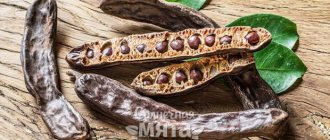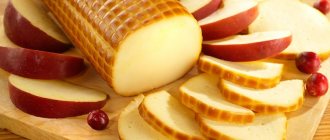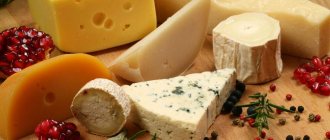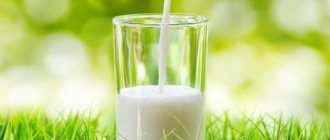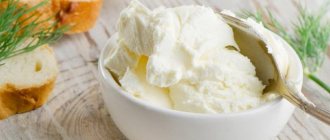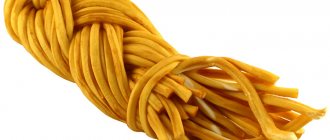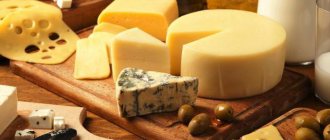12/17/2014 / Dairy products
| Maasdam cheese, BJU and calorie content per 100 g of product | |||
| Calorie content 350 kcal | Proteins 23.5 g | Fat 26 g | Carbohydrates 0 g |
A representative of natural semi-hard cheeses, it is made from cow's milk and aged for 1-3 months. It was named after the small town of Maasdam, located in the Netherlands. It is a competitive product for Gouda and Edamer cheeses. Externally, the cheese is riddled with large depressions, which are formed due to the release of gases during ripening. It has a sweetish taste and pleasant aroma.
Beneficial features
The benefits of this cheese lie in its unique chemical composition. Essential amino acids provide building blocks for many cells in the body. Vitamin “B9” is involved in hematopoiesis and amino acid metabolism, vitamin “C” is an antioxidant, improves immunity, and participates in the production of collagen in the skin. Calcium in cheese helps strengthen bones, improves the function of the heart muscle, and has an anti-inflammatory effect.
Maasdam cheese is recommended to be included in the diet of people with kidney disease, heart disease and hypertension. Due to its high calorie content, mineral and protein content, it is included in the diet of children, nursing women, people engaged in heavy physical labor and patients during the recovery period after fractures.
Maasdam: composition, effects and harm, description of Maasdam cheese
Maasdam is a naturally aged Dutch hard cheese. The product is named after a small town in the Netherlands - Maasdam. He is extremely popular in Russia.
Maasdam appeared as a result of experiments by cheesemakers in the 14th century, out of a desire to create a cheaper and more accessible product similar to the famous Emmental cheese. Therefore, some similarities can be discerned in the structure of these varieties.
Maasdam has a sweetish-nutty taste, it is obtained by adding field mustard, pepper grass and cloves.
The cheese also has a delicate creamy aroma, since it is made from pasteurized cow's milk.
The cheese base is light cream in color, and its crust is yellow, sometimes with a waxy coating on it. The head of cheese is large with rounded edges, the weight of an average head is from 6 to 12 kg.
A characteristic feature of Maasdam are holes in the cheese body, also called cheese eyes. They appear as a result of cheese ripening. The resulting gas squeezes out the surface of the product and bulges appear.
There are 2 main types of Maasdam cheese - young and aged. The young type of Maasdam ripens for at least a month, and the aged variety takes more than 6 weeks.
Curious! There is a legend that Peter 1, when he saw Maasdam cheese, was outraged by its appearance, thinking that mice had gnawed the holes.
Compound
The caloric content of Maasdam is quite high, so during the period of weight loss it should be consumed in limited quantities.
The cheese is characterized by a large amount of protein and almost the same amount of fat; there are no carbohydrates in the cheese. Maasdam contains saturated and polyunsaturated fatty acids, a resource of essential amino acids - tryptophan, isoleucine, lysine, methionine and organic acids.
The cheese contains many vitamins: A, group B, E, D, K, PP. In addition, it contains minerals: calcium, potassium, sodium, phosphorus, selenium, zinc, iron.
Benefit
- Maasdam is perfectly absorbed in the body, as it contains milk protein and fats.
- The high content of calcium and phosphorus is beneficial for the skeletal system, teeth, and nail plate, and vitamin D helps these and other minerals to be better absorbed.
Daily consumption of Maasdam is useful in the prevention of osteoporosis, after injuries and bruises. - Due to its chemical composition, cheese is an excellent source of energy. It is indispensable during periods of heavy physical and mental stress, as well as in the nutrition of athletes, pregnant and lactating women, and children.
- The use of Maasdam, due to the content of potassium, iron and copper, is useful for people with anemia and problems of the cardiovascular system. The low salt content does not cause an increase in blood pressure, so cheese can be used for hypertension.
- Minerals in cheese improve metabolism and the functioning of the genitourinary system.
It is recommended for people with kidney disease. - Zinc in Maasdam is beneficial for men, as it affects the health of the reproductive system. In addition, zinc improves memory and helps concentration.
- Due to the large amount of amino acids, cheese perfectly improves immunity and restores the vitality of the body.
- Regular use of Maasdam slows down the aging process and prevents the occurrence of malignant tumors.
Harm
It is worth abandoning Maasdam if you are individually intolerant to the product. Although cheese is very healthy, it should not be consumed in large quantities due to its high fat content. Cheese is also not recommended for colitis and diseases of the gastrointestinal tract.
How to select and store
When buying Maasdam, you need to pay attention to the cheese eyes. It is believed that the larger the holes, the more seasoned the product is, and preference should be given to cheese in large heads. Be sure to, if possible, ask the seller to cut off a small piece. It should not break or crumble. Unpleasant odors, for example, the smell of ammonia, indicate that the cheese is spoiled.
Important! Maasdam should be stored in the refrigerator, wrapped in cling film or foil.
Use in cooking
Maasdam cheese is a universal product. It is an excellent stand-alone snack and an excellent ingredient in recipes for various dishes. Cheese goes well with fruits, vegetables and nuts. Maasdam can be served with olives and sweet wine, they will highlight the elegant taste of this cheese.
Cheese is added to various casseroles, French fries, delicious pizza, salads and other dishes. You can also put it in hot sandwiches and cheeseburgers. Cheese is used in sauce recipes that go with meat and fish. The famous cheese fondue is prepared on the basis of Maasdam.
Source: //dom-eda.com/ingridient/item/maasdam.html
Application
There are two subtypes of Maasdam cheese: young (ripening time about a month) and aged (ripening for more than 6 weeks). Depending on the ripening time, the strength of the taste and aroma of the cheese depends.
This product is widely used in cooking as a separate dish and in preparing a variety of dishes. Often used as an appetizer for sweet wines. Pairs well in dishes with grapes, tomatoes and olives. On the basis of this cheese, ideal sauces for meat dishes are prepared, the famous fondue is also added to salads. For example, you can make a light salad by combining Maasdam cheese with squid, canned pineapple slices and chicken eggs. The salad is dressed with mayonnaise and turns out to be very high in calories.
Market Analytics
- COVID-19 is changing the rules of the game in the cosmetics market
- Beauty of the future: cosmetic innovations 2020
- New ingredients are the driving force of the cosmetics industry
Convenient search for beauty salons on our website
Beauty salons in Moscow Beauty salons in St. Petersburg Beauty salons in Ekaterinburg Beauty salons in Novosibirsk
Latest blog posts on our website
- Naturecream / Geranium (Pelargonium) oil for skin health and beauty
- Prostye-sovety / Save on a beauty salon: procedures that can be done at home
- Naturecream / Growth Factor - brings back youth?
- Oksana-Lezina / 3 effective abdominal exercises from a fitness instructor for beginners
- Prostye-sovety / Making perfect curls at home
- Prostye-sovety / Which hair removal method to choose
- Naturecream / Wrinkles Puppets
- Naturecream / PEPHA-TIGHT - instant skin lifting
- Naturecream / Blue light - a danger to the skin
- Naturecream / Cocoa Butter – A treat for the skin
Latest forum topics on our website
- Mrs._Smith / Badly sunburned! What to do?((
- Ice / Is it necessary to combine fitness classes with a diet?
- Antonova / What can be used for hair loss?
- Radio operatorKat / Who was on a protein diet?
- Suzanna / Mesotherapy on the face
Other articles in this section
| Sour cream 12% Sour cream is a product that dates back to ancient times. People tried to make the most of what nature gave them. Cow's milk is no exception. To prepare sour cream, you need to skim the cream from the milk and then add fermentation products (special bacteria) to it. After some time, the sour cream is ready. Depending on the fat content of sour cream, it can be divided into several types, each of which is used in cooking. Sour cream 12% is a low-fat product. |
| Milk 0.1% (skimmed) Milk is one of the most valuable products in the human diet. It has been established that it contains more than fifty active biological substances that are important for ensuring the normal functioning of all systems of the human body. Milk varies in quality. It has a different chemical composition and fat content, so its value depends on all these parameters. Since a healthy lifestyle has been actively promoted in recent years, skim milk has become increasingly popular. |
| Buttermilk 1% Buttermilk is a product made from milk. Buttermilk is typically obtained during the making of butter. The taste of this drink may be similar to low-fat kefir, sometimes it can be a little sweet, may have no odor at all, or have a pronounced acidity and aroma. |
| Low-fat cow's milk matsoni Matsoni is a product made from sour milk. This product is traditional for the cuisine of the Caucasus region, the Middle East and Central Asia. In different places on our planet you can find different names for this fermented milk product - in each culture it has a different name: Tsvela, Tsola, Matsun and many others. |
| Cheese Hermelin This is a delicate, noble cheese with white mold. Hermelin is produced in the Czech Republic; its name means “ermine” in Czech. In appearance, Hermelin cheese is similar to the well-known French cheeses: Camembert and Brie. It is important to note that Czech cheesemakers used Camembert as the prototype for Hermelin. It is made from high quality cow's milk. The head of cheese has a tender, viscous center and a pleasant, dense, white crust. |
| Low-fat condensed milk with sugar Preserving milk by evaporation was invented by a resident of France, Nicola Apperou. At the time of evaporation, sterilization also occurred. This pastry chef worked in Paris and one day discovered a very interesting fact. When he boiled the juice, it began to be stored in canned form for quite a long time. After that, he began experimenting with milk. As a result, the confectioner realized that after it was boiled, it would be stored in tin jars for a long time. Tin cans were used because glass ones tended to burst when steam sterilized. |
| Fruit yogurt 1.5% Fruit yogurt is a tasty and healthy product that can be both light and particularly nutritious. In fact, it is no different from the usual classic version of yogurt without any fillers. Except that at the final stage the optimal amount of the desired fruit component, which can be presented in various forms, is added to the finished fermented milk product. |
| Fontina cheese This type of cheese has been produced in the mountainous regions of the Alps since the Middle Ages, and Italy is considered its homeland (namely, the province of Val D'Agosta). Delicate Fontina cheese with an exquisite taste and unusual aftertaste is today known and loved all over the world. |
| Acidophilus 0.1% Acidophilus 0.1% is a fermented milk product that is obtained by mowing milk. For starters, use kefir sticks or acidophilus starter. This is a relatively new product and has not yet been appreciated, but Acidophilus 0.1% has already found its fans. The product comes in varying degrees of fat content, depending on the milk being fermented. |
| Dutch cheese Dutch cheese is one of the most popular and widespread varieties of cheese. Its peculiarity is that it is always prepared only from fresh cow's milk, and sterility is a prerequisite for production. The recipe for making Dutch cheese has remained unchanged for about 150 years. It tastes milky, salty and slightly spicy. The color should range from milky white to pale yellow; if the cheese is bright yellow, then coloring has probably been added to it. The ripening period is from 30 to 60 days, no more. |
Maasdam cheese, calorie content and dietary properties
Mar-1-2013 KoshkaS
Such widespread and well-known varieties of cheese as Gouda and Edamer are only slightly ahead in popularity of such a variety of hard Dutch cheese as Maasdam cheese.
But among the great many of its lovers, there will probably be those who are seriously struggling with excess weight or simply taking care of their appearance.
So let's figure out what kind of product this is, what calorie content Maasdam cheese has, what the benefits of this cheese are and whether it has any dietary properties.
The main characteristics of this cheese are large spherical eyes and a sweetish, nutty taste. With its sweet taste, Maasdam is a bit reminiscent of the sweeter and more expensive Swiss Emmental.
The color of Maasdam cheese is pale yellow. Large spherical cavities—eyes—are clearly visible on the cut. The outside of the head of cheese is covered with a yellow-red crust, in some cases with a waxy coating. The taste of Maasdam is sweetish and nutty with a delicate aroma. This original taste is obtained by adding field mustard, nettle and pepper grass, as well as cloves..
It is worth noting that all consumer and taste properties of the finished Maasdam cheese completely depend on its ripening time. Moreover, all cheeses of this type are divided into young and aged.
The first type matures for 4 or more weeks, naturally aged even longer.
But Maasdam cheese gets its characteristic cheese holes due to the formation of gases in it, which is a natural ripening process.
Maasdam cheese is a universal product that can be an excellent independent snack, as well as used in recipes for various dishes. This product goes well with sweet wines, grapes, olives and tomatoes.
A sauce is prepared on the basis of this cheese, which goes perfectly with meat, poultry and red fish. In crushed form, it is added to French fries, pizza, casseroles, salads and other dishes. For dessert, Maasdam is served on a cheese plate.
A popular fondue is prepared based on this cheese.
Dietary properties:
So, the birthplace of this wonderful product is Holland, or rather the city of Maasdam. It is from the place of its “birth” (like many other cheeses) that its name comes.
Maasdam cheese is a Dutch cheese with a Swiss taste, one of the representatives of naturally ripened cheeses, the recipe of which was developed by Dutch masters in order to displace the market position of the popular Emmental.
Of course, this did not happen, but in this regard the Dutch succeeded, because the cheese turned out to be tasty and sweet, and Maasdam took an equally worthy place among the famous European cheeses.
In the production of this dairy product, almost the same components are used as in Swiss cheeses, but Maasdam has a higher moisture content, and it ripens faster. For this reason, the cheese turns out softer and juicier. Compared to Emmental, the cost of Maasdam is more attractive.
The reason for the specific taste (light sweetness) lies in special bacteria. They are added to the cheese at a certain stage of preparation. Sometimes Maasdam cheese is made from goat's milk. As with its classic version, the same set of ingredients is used to prepare this cheese.
In cooking, among restaurant dishes, Dutch Maasdam cheese is very popular. It is usually served with olives or grapes with dry red wine.
Nutrition experts and doctors recommend consuming a small amount of hard cheese such as Maasdam every day. Moreover, the milk proteins and fats included in its composition are perfectly absorbed by the human body, which receives a regular dose of substances and vitamins necessary for normal functioning.
Unfortunately, in addition to its benefits, this cheese can also cause harm. It is worth emphasizing that harm from this cheese can occur if the product is consumed in large quantities. In addition, this cheese, consumed in large quantities, can harm people with diseases of the gastrointestinal tract, as well as with high stomach acidity or colitis.
Cheese is a wonderfully tasty, easily digestible and very healthy food product. The beneficial properties of cheese are due to the presence in its composition of B vitamins, vitamin A, minerals (especially calcium), and proteins. In addition, it contains essential amino acids, such as lysine, methionine and tryptophan.
In addition, cheese is an excellent source of energy, so it is recommended to include it in the diet of people engaged in heavy physical labor or sports. Containing many minerals and proteins, it is an ideal product for children, adolescents, women during lactation, as well as for people recovering from fractures.
About calorie content:
Now let's talk about the nutritional value of this product.
The calorie content of Maasdam cheese is:
350 kcal per 100 g. product
Protein, fat and carbohydrates (BJU) of Maasdam cheese in gr. per 100 grams:
Proteins - 23.5
Fats – 26.0
carbohydrates – 0.0
The fat content of the product is 45%, and its carbohydrate content is almost zero.
Weight loss:
Does this cheese have any dietary properties? And in general, is it possible to use hard cheeses in weight loss diets? After all, the calorie content of this product is far from small. It turns out that it is possible! There are also types of diets such as the cheese diet. This is one type of protein diet that is used to quickly lose weight.
This, of course, should be done after consulting the appropriate doctor. And if you have no contraindications, then this diet is worth trying. After all, as already mentioned, cheeses are a source of many substances valuable for human health. Such a diet will be especially useful in the summer, when meat gets boring and we move on to vigorous consumption of vegetables and fruits.
It is precisely at this time that cheese can replace meat as a source of protein.
As for Maasdam cheese, it is unlikely to be used in a diet for weight loss, since in such diets cheeses with low fat content are used, in the range of 10-13 percent. Where is this cheese with its 45 percent!
Can I cook any dish with this cheese? Of course you can! Here is one of the recipes:
Sandwiches with Maasdam cheese:
Products:
- Bread - 2 slices
- Sausages with cheese - 2 pieces
- Cheese Maasdam
- Butter
- Herbs de Provence seasoning
The bread is carefully cut into beautifully shaped pieces. The bread is then buttered. If the bread is warm, the oil may be absorbed.
The bread is then sprinkled with Herbs de Provence seasoning (you can also use other seasonings at your discretion). Lay out slices of cheese and sausage (cut lengthwise). Sandwiches are baked in the oven for 15 minutes.
Ready! Eat to your health, just remember that the calorie content of Maasdam cheese is quite high.
Source: //prokalorijnost.ru/syr-maasdam-kalorijnost-polza-dieticheskie-svojstva
Types of ripening of Maasdam cheese
The process of making Maasdam cheese at home is not possible without the ripening stage. This process is very important, so certain conditions should be created for it. Otherwise, the product may turn out to be of low quality and tasteless.
Warm ripening
Warm ripening is only possible in a fermentation chamber. It is installed in a room with air humidity of 85-90% and a temperature of about 20° C. For maasdam to ripen in such conditions, it will take 20 days.
This type of ripening is characterized by a high level of humidity and low temperature in the room where the milk cheese is stored. You can recreate such conditions as follows: place the milk product in a vegetable box, cover it, and place a jar of water next to it. It is important to turn the milk maasdam over 2 times a day.
The conditions for cold ripening of the second type of Maasdam are very similar to the previous version. Cheese made at home is placed for ripening in a room with the following conditions: room temperature at 10 ° C, and high humidity created by an open container of water. In such conditions, milk cheese ripens for about 10 days.

